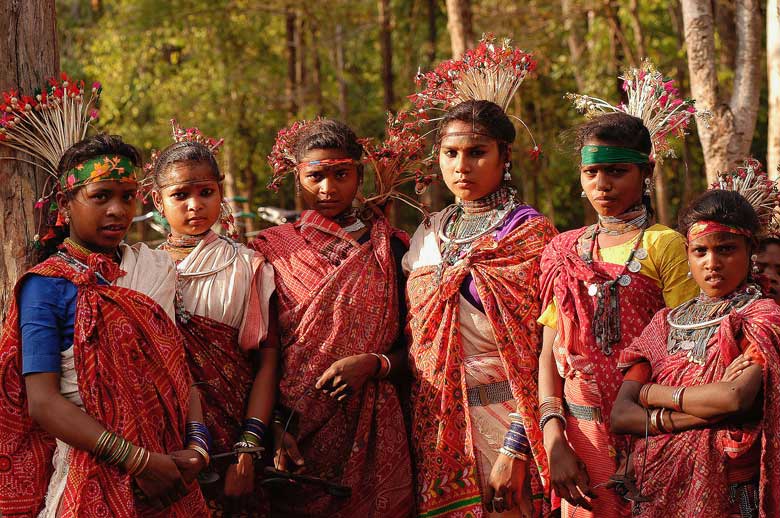Andaman and Nicobar is a tropical paradise that boasts of pristine beaches, green forests and chirping rare birds. It is also home to some of the oldest tribes in India.
The indigenous tribes residing in Andaman and Nicobar are characterized by their distinct cultural traditions. Their unique dressing style reflects this rich culture.
Natural Materials
Across the islands, the use of natural materials adorns the indigenous costumes. While modernization has impacted many of the local tribes, it is important to maintain a balance between adopting new styles and honoring the cultural heritage of Andaman nicobar.
The islanders are a blend of Hindus, Christians and Muslims and showcase their cultural identity through their traditional attires. Women in Laccadivian communities wear a black or white lungi that resembles a saree and pair it with ornaments crafted from seashells and bark fibers. The Nicobarese, who are primarily Hindus, also adorn themselves with necklaces made from shells and waistbands and arm bands made from bark fiber.
Most of the Andaman and Nicobar tribal people have a close connection to nature and they reflect this through their dressing style. For instance, the Sentinelese tribe is believed to have migrated from Africa and still follow their primitive way of living. They are completely naked and remain detached from the influence of modern civilization. The Jarawas, another tribe, adorn themselves with a variety of hats and necklaces that are carved from shells and tree bark.
Similarly, the Shompens are a group of indigenous tribes who live at Car Nicobar and the Mawa Shompens. They have a close relationship with the ocean and practice several methods for exploitation of marine resources, including trapping, thanam kak, and chok chok (fishing using bamboo spears). The tribes are highly skilled in weaving fabulous mats and hangings out of various organic items and can be found at select emporiums and markets.
Sea-Shell Ornaments
The Andaman and Nicobar Islands are home to indigenous tribes who still retain their cultural heritage in the face of modernisation. This culture is reflected in their clothes, which are made of local materials. For example, men and women wear traditional cloths such as loincloths. This clothing reflects their close connection to nature and highlights their unique identity.
Besides displaying their traditional attire, the Andaman nicobar islanders also use sea-shell ornaments in their dressing style. Queen Sea Covering Craft is one such shop that specializes in this art, where visitors can purchase exquisite ornaments like bangles, earrings and photo frames that are adorned with beautiful sea-shells. These ornaments are an essential part of the Andaman nicobar clothing style and are sure to enhance the appeal of the wearer.
In addition to these, the Andaman nicobar people are experts in wood and bamboo craftwork. The islanders produce furniture and other wooden items from raw materials like padauk, Badam and Gurjan and also driftwood and bamboo coral. The Andaman nicobar handicrafts also include bamboo and cane baskets, lamps and other decorative pieces.
The shelves of Port Blair’s lively street markets are stacked with small bamboo figurines and mats that are beautifully carved by Andaman islanders. These crafts make a great souvenir that will remind you of the islands. They are an important part of the Andaman nicobar dressing style, which is characterized by a combination of traditional indigenous styles and influences from mainland India.
Unique Aesthetics
At a time when modern fashion dominates the multi-screen cinema halls of major cities in India and around the world, Andaman nicobar has its own unique aesthetics that are rooted in the indigenous tribal traditions and influenced by migrant communities. The islanders wear traditional dresses like salwar-kurta, dhotis, shirts-pants and trousers and embellish them with ornaments crafted from natural materials such as sea shells.
These tribes are very close to nature and they maintain a healthy connection with the environment through their dressing styles. The Sentinelese tribe for example, walks nude despite the advances of civilisation while the Jarawas wear only adornments made from bark and shell.
The people of Andaman and Nicobar are primarily Hindus, but there is also a significant Muslim minority. They exhibit their religious identities through their traditional attire and adornments. These adornments have been inspired by the forests, sea creatures and even by tree branches.
The islanders have a rich cultural tapestry that is enriched by the various influences they have encountered over the centuries. These include the Negroid and Mongoloid tribes of Andaman, along with migrants from the Indian mainland who have contributed to the culture of the islands. The islanders are also home to the enigmatic Andaman and Nicobar islands tribes which have been preserved by relative isolation from the civilised world.
Cultural Tapestry
The Andaman and Nicobar Islands have an abundance of natural resources that lend themselves to various artistic crafts, such as basketry, mat making, and shell adornment. The islands are also home to a wide variety of flora and fauna, making them a popular destination for ecotourism. However, due to concerns over exploitation, the islanders have implemented regulations to protect their precious natural resources. For example, the islands prohibit the trade of items made from mother-of-pearl (paduk), which can be found in the waters surrounding the islands.
The people of Andaman and Nicobar Islands have a rich culture, influenced by their indigenous heritage as well as the influences of early settlers and mainstream Indian traditions. The costumes of the islands reflect this cultural tapestry, seamlessly blending traditional elements with sea-shell ornaments and a sylvan ambience.
As the world around us continues to evolve, it’s important to keep a balance between embracing new styles and maintaining the integrity of our own traditions. And this is exactly what the people of Andaman and Nicobar are doing.
The Sentinelese tribe still maintains a life free of clothing, while the semi civilized Shompens only cover themselves from the waist up. The people of Car Nicobar, on the other hand, have shifted away from their traditional coconut-leaf petticoats and now wear modern clothes.

